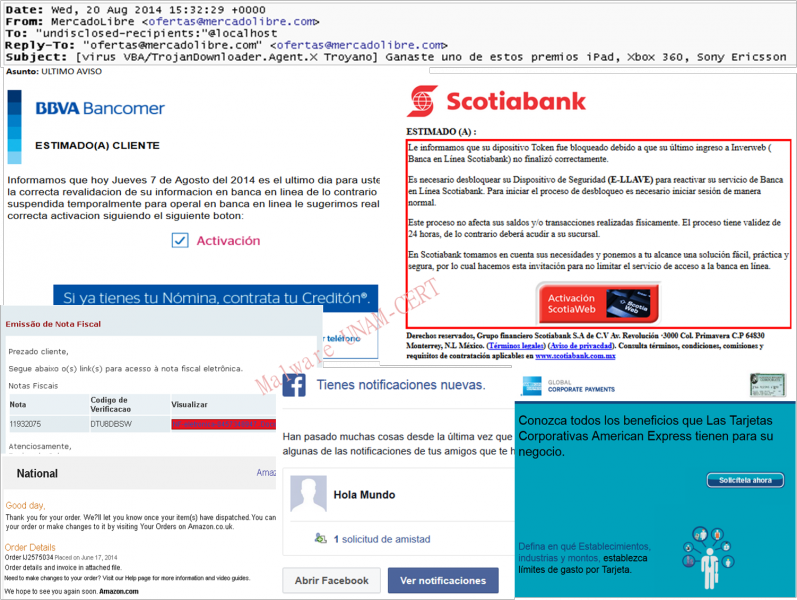Facebook comments carry out pharming against mexican banks
A fake email from Facebook was spread in December. The email shows a message about an alleged comment from Sammy Villanueva.

When the link is opened, it redirects to where it was downloaded a malicious executable file called ComentarioSammyVillanueva.exe.
Pharming and Phising in Brazilian sites
Some days ago we received a mail, which notified about a malicious code propagated using a URL as the following:
http://XXXXXXX#/fotos_flagrante-Dilma.JPEG?0.25970
The file could be downloaded from the previous link, it is identified as fotos.com. So far, the antivirus engines that detect it as a threat, are the following:
Fareit troyan sent by mail that steals passwords from FTP services and browsers
Summary
This report presents the analysis of a variant of the Fareit family. This malware has characteristics of dropper because it contains a malicious batch script that is created and executed on the infected computer, and of spyware, as it collects information of the accounts stored on the FTP applications, browsers and email clients of the users without their consent.
Infection campaign by the downloader Upatre and the Trojan Dyre through emails
Abstract
On this report we show the analysis of a variant of Upatre, which is a trojan downloader that has as its primary function to download other files from remote servers, such as a sample of the Dyre family. These variants are sent through spam emails with attachments.
A glimpse to the phishing and malware situation in Mexico (August – September)
Abstract
We have all received at least one fake message in our email accounts looking to obtain personal information (such as users, passwords, credit card data, etc.) or that redirects us to websites that download malicious programs. These emails, which appear to come from a reliable source, are known as phishing and make use of social engineering techniques to trick users. The following report shows a general analysis of several malware samples related to phishing websites that were reported to UNAM-CERT, this with the objective of showing some of the most common cases and reducing the number of affected users.

Malware downloads from fake site to consult CURP (a population registry code in Mexico)
Abstract
In this report we describe the analysis of a sample obtained from a site where Mexican users could supposedly consult and download their CURP (Unique Population Registry Code). The trojan gathers information about the system, cipher it and then send it to remote servers. It also uses three different methods to maintain its persistence on the infected computer.
Static analysis of the Dalixy worm
Abstract
In this blog entry is documented the analysis performed to a variant of the Dalixy malware family, also known as LdPinch, Dalia or Trodal. Dalixy is a malicious program with characteristics of both a worm (sending itself through email) and a bot (communication through an IRC chat).
Valentine's Day Malware
During holidaysmalicious activity increases because the attackers are usually more successful in deceiving users and taking advantage. Valentine's Day is one of the best examples of this; which is why the malware analysis team of UNAM-CERT decided to publish a report about a sample that, although it’s not recent, illustrates very well the dangers of falling into the frauds of the creators of malicious code.
User's information redirected to malicious proxy servers
UNAM - CERT received in recent days, a report about a malicious file that redirects the information of the infected users to a proxy server in order to read specific data and steal credentials from legitimate sites without the user noticing; for this reason, a research about the case was started.
_2.png)